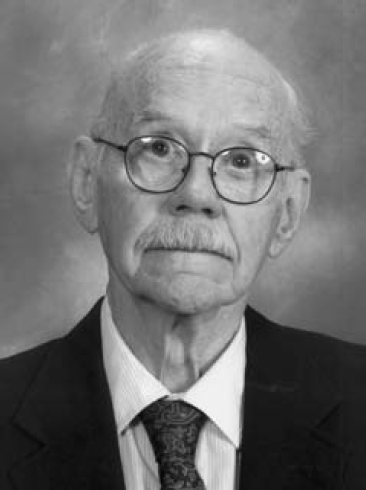
1922–2010
Elected in 1979
“For contributions to nuclear ordnance engineering, particularly in systems concepts, command, control, intelligence, and safety.”
BY JULIA M. PHILLIPS
W. J. “JACK” HOWARD, a former executive vice president at Sandia National Laboratories who was a valued national advisor on U.S. nuclear policy, passed away September 13, 2010, at the age of 88.
Born in Kimball, Nebraska, on August 25, 1922, Howard came to New Mexico with his family when he was a junior in high school. He graduated from what is now New Mexico State University with a bachelor’s degree in mechanical engineering and served in World War II. While serving at Clark Air Force Base in the Philippines, after a mountain airplane crash that killed the pilot, he hiked for six days along a stream with a shattered kneecap, until he found help. During his military service he earned the rank of captain and the Combat Infantry Badge, Bronze Star, and Purple Heart.
In 1946, Howard joined the Z Division of Los Alamos National Laboratory, which became Sandia National Laboratories in 1949.
During his career at Sandia National Laboratories, Howard racked up a notable list of achievements in weapons work. He directed the ordnance engineering design and development of the first Polaris missile warhead, which led to Sandia receiving a Certificate of Merit from the U.S. Navy. In addition, he was the motivating force behind the concept of the nuclear warhead
and delivery system, which led to what is known as the “Davy Crockett” infantry weapon system. The system was designed for use by the U.S. infantry in Europe against Soviet troops during the Cold War.
Safety and control of nuclear weapons were priorities of Howard. “He was a forward-looking person in a very pragmatic sense,” according to Orval Jones, a former executive vice president at Sandia who first worked with Jack in 1973. “Jack saw the need to really aggressively pursue nuclear weapons safety.” To prevent unauthorized detonation of nuclear weapons, he recognized early the need for built-in control of the arming sequence of U.S. nuclear weapons. He participated in the preliminary design of the Permissive Action Link (PAL) system, a coded switch inside a nuclear weapon that blocks the arming signal and requires an order from the President of the United States to pass through the proper channels for activation.
In 1969, Howard was instrumental in establishing an independent nuclear safety assessment group at Sandia. The group oversaw an ongoing safety review of existing nuclear weapons, developed new safety technologies, and developed techniques for evaluating evolving safety concepts.
Perhaps Howard’s most publicly visible achievement was his leadership of the California site of Sandia National Laboratories in Livermore. In 1956, Howard was assigned to inaugurate the new laboratory to provide ordnance engineering support to what is now known as Lawrence Livermore National Laboratory. Retired Sandia Laboratory Director Tom Hunter recalled, “I would describe Jack as one who laid the foundations not just for our nuclear weapons program but also for [Sandia’s] values of national service and excellence.”
Concurrently with his tenure at Sandia, Howard became a valued advisor in formulating and guiding the implementation of national nuclear policy and served the nation in various capacities. From 1963 to 1966 he served as assistant to the secretary of defense for atomic energy at the U.S. Department of Defense (DOD) and was the chairman of the Atomic Energy
Commission’s Military Liaison Committee. During this time he assisted with ballistics support to locate a missing nuclear weapon near Palomares, Spain, after the collision of a B-52 and tanker aircraft during a refueling operation. Defense Secretary Robert McNamara awarded Jack the DOD Medal for Distinguished Public Service for his work. In 1976 he was appointed to serve as a delegate to the Strategic Arms Limitation Talks in Geneva, Switzerland.
Howard retired in 1982 after 35 years at Sandia, nine of them as executive vice president. He was inducted into Sandia’s Hall of Fame in 2010, only the third Sandian to be so honored. This honor recognizes former employees who made pivotal contributions that have significantly enhanced Sandia. As Labs Director Paul Hommert said: “Jack Howard’s contributions to Sandia and [to] national security were immeasurable, from his nuclear weapons work to his advocacy of nuclear weapons safety to his leadership establishing Sandia’s California site. His actions over a 36-year career shaped the Laboratory into what it is today, and for that we are grateful.”
In his retirement, Howard enjoyed flyfishing, golf, and his home and family. He received an honorary doctorate from New Mexico State University and was elected to the National Academy of Engineering in 1979, “for contributions to nuclear ordnance engineering, particularly in systems concepts, command, control, intelligence, and safety.”
Howard was preceded in death by his wife of 61 years, Georgia. He is survived by his daughter Melissa Howard, of Cedar Crest; his son Andrew and wife Sandra Howard, of Chicago; his granddaughter Rebecca Howard and husband Oliver Soell; grandson Gabriel Howard; and his dog Cruces.




